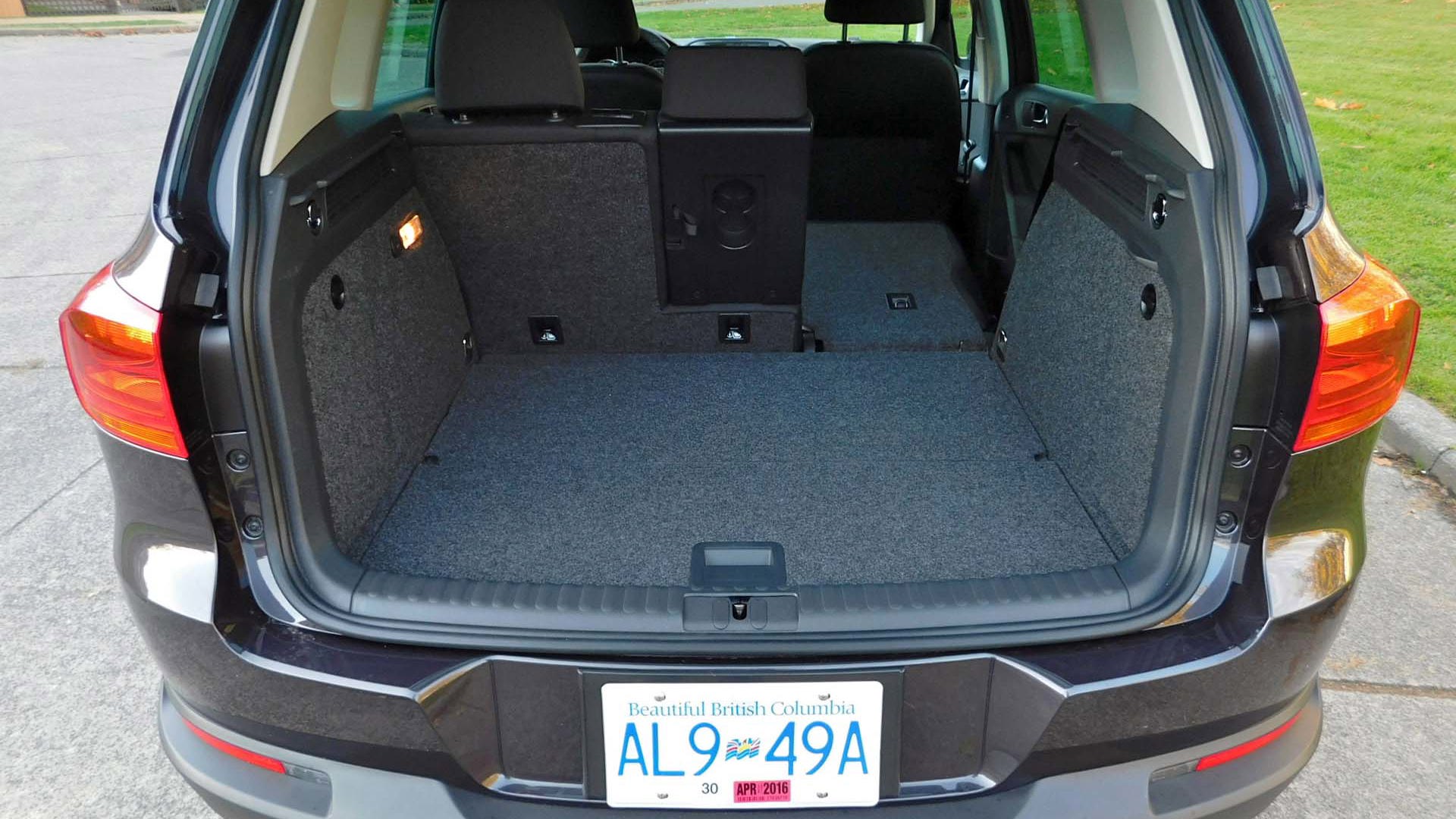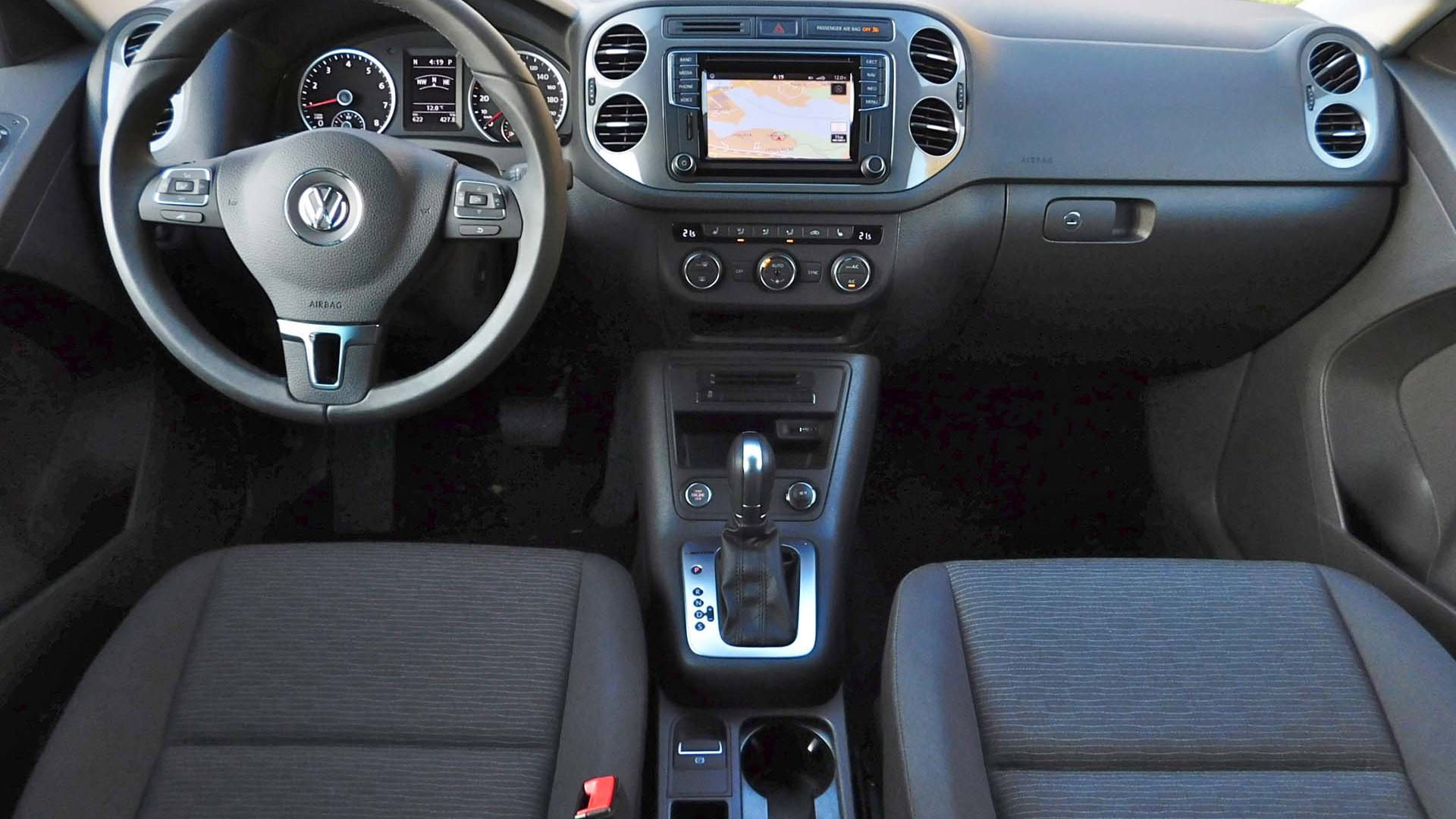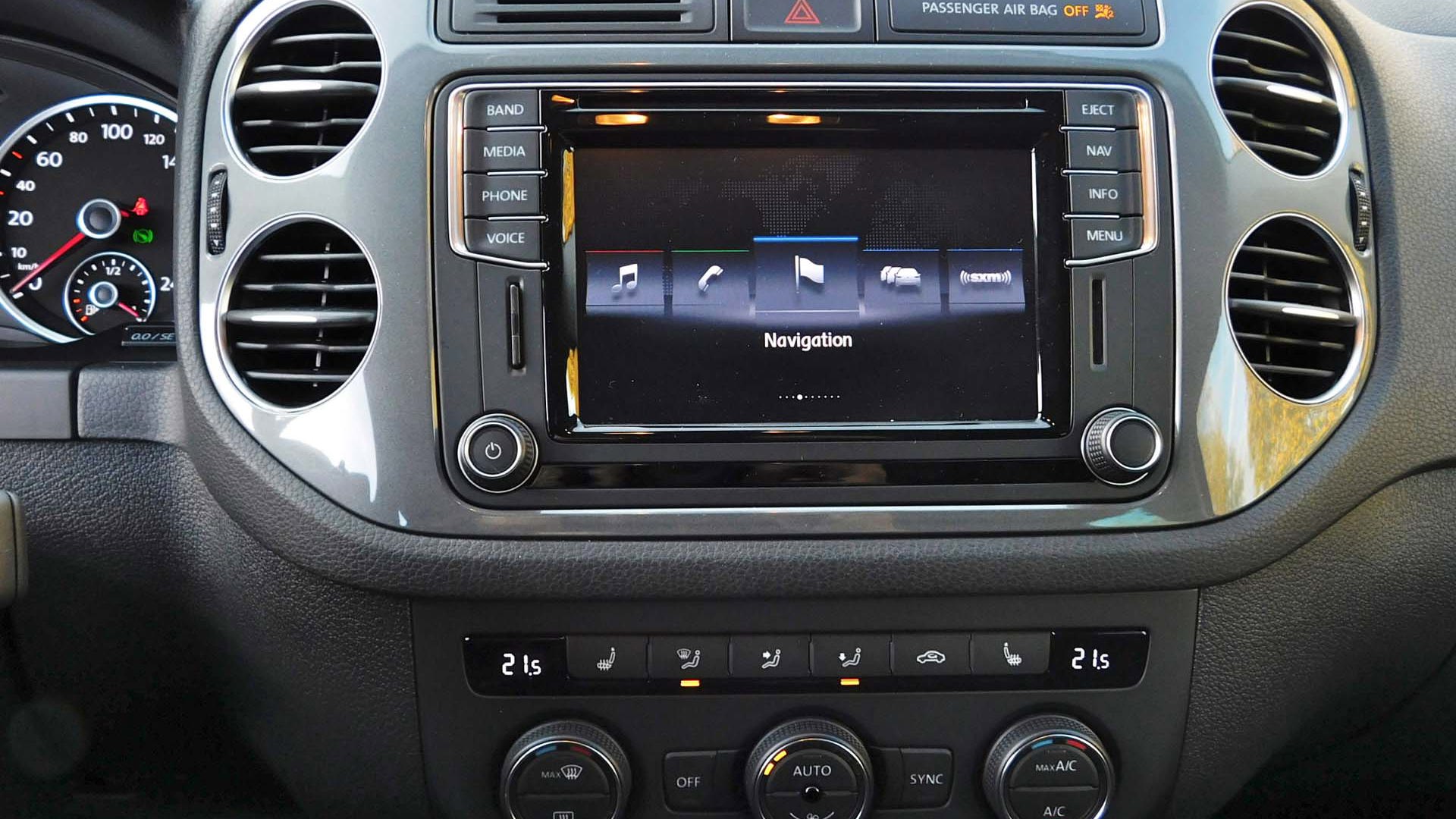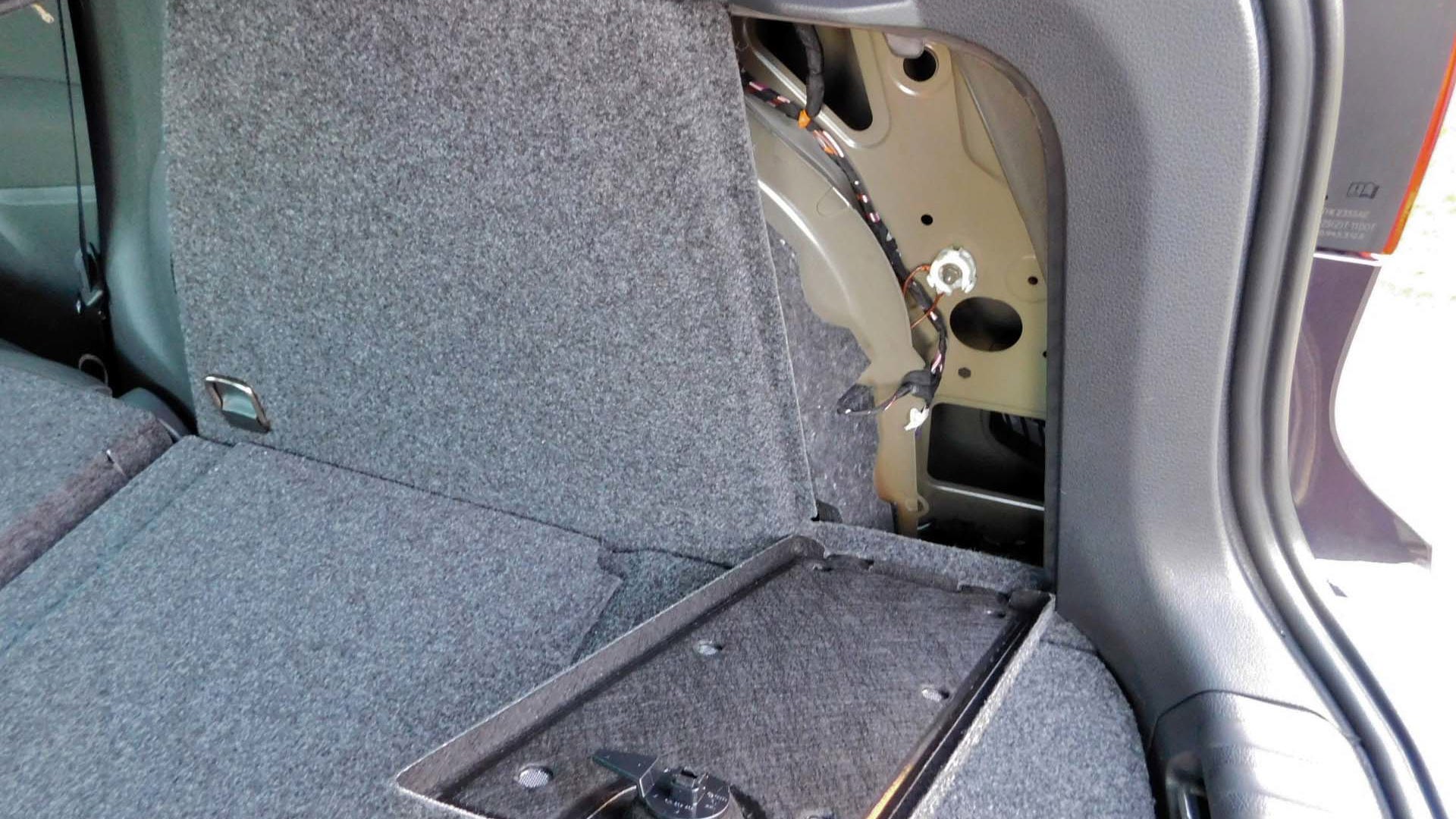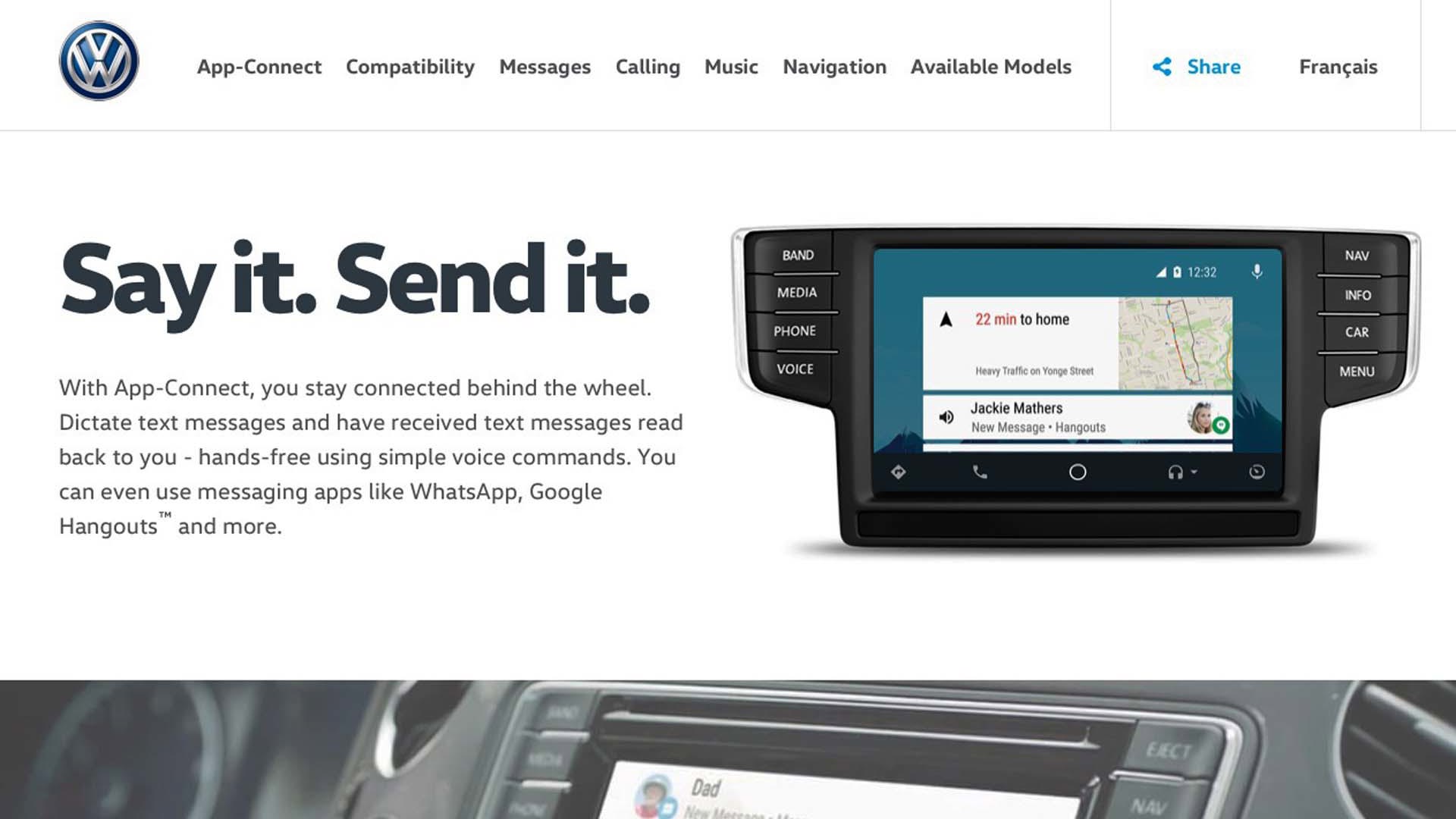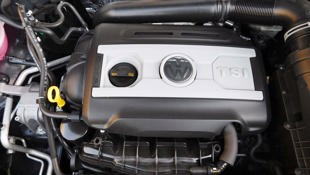 AutoTrader SCORE
AutoTrader SCORE
-
INTERIOR8/10
-
EXTERIOR STYLING7/10
-
FUEL ECONOMY7/10
-
PERFORMANCE8/10
-
COMFORT8/10
Introduced to North America for the 2009 model year, Volkswagen's Tiguan has never exactly sold like the proverbial hotcakes. Instead, in a segment that trades on practical attributes, the Tiguan has been a bit of a niche player, with a quintessentially European focus on driving dynamics and refinement over outright utility.
In a segment that trades on practical attributes, the Tiguan has been a bit of a niche player, with a quintessentially European focus on driving dynamics and refinement over outright utility.
It's an approach that lately has left the Tiguan awkwardly straddling the gap between car and CUV. On one side is Volkswagen's roomier and more efficient Golf Sportwagon, which offers the even more dynamic driving experience of an actual car, while on the other side are more practical CUV offerings from the likes of Ford, Toyota and Honda (not to mention Hyundai, Mazda, Chevrolet, Nissan, Kia, and the list goes on).
In terms of numbers, Ford claimed Canada's compact CUV podium in 2015 with 47,726 Escapes sold, while Toyota and Honda took second and third place with 42,246 RAV4s and 38,961 CR-Vs respectively. Volkswagen, meantime, sold only 11,459 Tiguans in the same period.
Combine this with the promise of a larger and more practical new three-row Tiguan announced for 2017 (which was recently shown in two-row Euro spec at the Frankfurt Auto Show) and with Volkswagen's self-inflicted Dieselgate scandal (which had Canadian newspapers, television and social media flooded with apologetic corporate advertisements during the week I was test driving a brand-new 2016 Tiguan) and you have all the makings of a dismal year for the German automaker's little CUV.
Certainly the comments from my friends and family didn't bode well. "Oh, a Tiguan!", they'd joke, "It's not a diesel is it? Bwha-ha-ha!" Or "Hey, are they still allowed to sell those? Hee, hee, hee." Never mind that the Tiguan was never available here with a diesel.
It turns out, however, that the outgoing Tiguan still has a few surprises up its sleeve, and against all expectations it closed 2015 with some of its best sales numbers ever. Tiguan sales in 2015 were up some 14 percent in Canada compared to 2014, and posted a 43 percent year-over-year increase in the U.S.
The secret lies in revamped pricing for the 2016 model that offers more standard equipment for less money, as well as some aggressive incentives offered by Volkswagen for willing consumers. One of my more astute neighbours, who's actually in the market for a compact CUV, summed it up nicely: "I should check the Tiguan out," he said, "because I bet you could get a really good deal on one right now." Indeed.
Changes for the 2016 Tiguan are limited to the introduction of a Special Edition model, various paint colour and alloy wheel changes, and some rejigging of which models can or can't have all-wheel drive (you can no longer get 4Motion in base Trendline trim, nor can you get a Comfortline trim in front-wheel drive).
The biggest news is in the infotainment department, where the 2016 Tiguan gets a selection of all-new improved systems. Gone is Volkswagen's annoying Media Device Interface plug, and instead you now get a proper USB plug. You also get retained power, so the system stays on after you shut off the engine, powering off only when you open the driver's door. Higher trim levels get a 6.3-inch colour touchscreen, while the base Trendline model gets a 5-inch screen – upgradable for a price, of course.
With the bigger touchscreen also comes Volkswagen's new App-Connect smartphone integration, letting you connect directly to your smartphone using Android Auto, Apple Carplay or MirrorLink to access your phone's built-in features including messaging, voicemail, music and navigation (on Volkswagen's website, App-Connect is shown displaying helpful navigation tips like "Heavy Traffic on Yonge Street," although it's not clear whether this actually counts as useful information, or mere obvious statement).
I found the touchscreen interface to be reasonably intuitive and quick-responding, and the system in my Special Edition test car played well with the basic functions of my Android-based phone. I did appreciate that Volkswagen has struck a nice balance between buttons and menu levels, so you don't get overwhelmed by either. In fact, that general comment could apply to the Tiguan as a whole: My wife, who quite liked it, summed it up as being "nice" and "not too intimidating."
It's also properly comfortable in a no-nonsense German sort of way. I found the Special Edition's cloth-upholstered interior to be a little unremittingly black, but the fit and finish was impeccable and I had no quibbles with the ergonomics (well, other than a bit of a complaint about the thick A-pillars, which hampered forward visibility more than I'd prefer). Controls are all logically placed and fall easily to hand, and soft surface materials are deployed wherever they're called for, including the dash top and dash face, front door uppers, door panel inners, armrests, and console bin top.
Lower trim models get eight-way manually adjustable seats, with power recline added for the driver in Comfortline trim, and a 12-way power adjustable driver's seat added in Highline trim. The back seats offer good space for adults, with 40/20/40 split-folding capability – this is the one area where the Tiguan clearly beats out its Sportwagon stablemate, which offers only 60/40 folding and has 7 mm less rear legroom and 11 mm less rear headroom.
On the downside, the Tiguan's rear seats can't be folded from the rear hatch, so you need to go around to the rear doors to create a flat cargo area. The Honda CR-V is much better in this regard, offering perhaps the slickest seat-folding mechanism in the industry and including releases both at the rear doors and at the rear hatch. Any of the CR-V, RAV4, Escape and Sportwagon offer more cargo room than the Tiguan too, at 1,054, 1,078, 971 and 861 L respectively versus a comparatively paltry 674 L for the Tiguan.
One might hope that smaller size would translate into better fuel efficiency, but here too the Tiguan comes up a little short against its main competitors, with official ratings of 11.6 / 9.3 L/100 km (city/highway) in all-wheel-drive trim, versus 9.5 / 7.5 for the CR-V, 10.5 / 8.2 for the RAV4, and 11.4 / 8.4 for the Ford Escape (all in AWD trim). The Golf Sportwagon, meanwhile, clocks in at 9.3 / 6.7 and runs on regular fuel, unlike the Tiguan, which requires premium. During my week with the Tiguan, in cool wet weather and with the odometer not yet reading 1,000 km (so the engine may not have been fully broken in) the best I saw was 10.8 L/100 km on a long drive with a 30/70 mix of city and highway conditions, and I noted that the Tiguan seemed to take longer than average to warm up before it could deliver its best efficiency.
Where the Tiguan does win out against its competitors is, as promised, in driving dynamics. I've heard it likened to a Golf GTI on stilts, and while this might be pushing things a bit (it's more on platform shoes than stilts) it's not an entirely unreasonable comparison. For sure, the Golf Sportwagon offers less body roll in corners and crisper handling near the limits (the Tiguan tends to get a little mushy when pushed hard, though this may be a function of the OEM tires as much as anything), but if you prefer the commanding driving position and available all-wheel drive of a CUV then the Tiguan is one of the sportiest and most dynamic CUVs available.
With its turbocharged 2.0L four-cylinder engine churning out 200 horsepower and a very respectable 207 lb-ft of torque, the Tiguan accelerates with easy enthusiasm (0-100 km/h can be dispatched in about 8 seconds), and the conventional six-speed automatic works smoothly and unobtrusively in the background. For a truly sporty experience it might have been nice to have paddle shifters (these are only available with the Highline trim when you add the $2,995 R-Line package), but the truth is they'd be a little lost on this transmission, which isn't near as quick-shifting as Volkswagen's dual-clutch DSG automatic. Switch the Tiguan's console shift into manual mode and you get a distinct delay between initiating a shift command and getting a response from the transmission.
In true Volkswagen tradition the Tiguan strikes a near-perfect balance between ride comfort and handling. The ride is never jarring or stiff, yet the Tiguan soaks up rough roads with aplomb and remains thoroughly composed when cornering within the limits. It's an agile-feeling CUV, and the steering offers pleasingly quick and accurate turn-in. On the highway the Tiguan is impressively quiet, with the engine turning over at just 1,750 rpm at 100 km/h, and little in the way of wind or tire noise.
In terms of comfort and convenience, the Tiguan checks most of the boxes. The cloth-upholstered base Trendline trim (starting at $24,990) gets air conditioning, alloy wheels (which get bigger as you move up), Bluetooth connectivity, cruise control, front fog lights, rearview camera, tire pressure monitoring system, exterior temperature display, electronic park brake and a touchscreen radio with auxiliary input. Moving up to the Comfortline trim ($33,998) adds features including all-wheel drive, automatic climate control, panoramic sunroof, leatherette upholstery, keyless entry with pushbutton start, leather-wrapped steering wheel and shift knob, plus an upgraded "Composition" infotainment system with 6.3-inch touchscreen, App-Connect, satellite radio and USB input port. The top-end Highline trim (starting at $36,998) adds further features including leather upholstery, navigation, interior lighting package, upgraded audio, 12-way power driver's seat, and chrome exterior trim. Notably absent in all this are any of the advanced driver-assistance safety features now turning up in some of the Tiguan's competitors, but one might argue that a car-load of electronic nannies would be out of place in a driver-oriented CUV like the Tiguan.
With a starting price of $29,990 (not including the $1,760 destination fee) my Special Edition test car fell somewhere between the Trendline and Comfortline in price, but included most of the desirable Comfortline equipment (including the 4Motion all-wheel drive, dual-zone climate control, heated front seats, keyless entry with push-button start, auto-dimming mirror, USB audio input, and leather wrapped steering wheel/gear knob). My test car also had a Special Edition navigation package ($995) that added the Discover Media system with 6.3-inch touchscreen and App-Connect smartphone integration.
At the end of the day it added up to a nicely equipped little CUV runabout with better than average road manners and a willing powertrain. Compact CUV buyers in need of maximum utility will want to check out the top selling offerings from Ford, Honda and Toyota, while those who value the Tiguan's driving dynamics might want to cross-shop the Mazda CX-5 and Volkswagen's own Golf Sportwagon. That said, for those who feel the Tiguan best fits the bill there's likely leverage to be had when it comes time to sit down and haggle, and with this in mind the Tiguan continues to represent an interesting, fun-to-drive choice in a very crowded marketplace.
| Warranty: 4 years/80,000 km; 5 years/100,000 km powertrain; 12 years/unlimited distance corrosion perforation; 4 years/80,000 km roadside assistance Competitors: |
| Model Tested | 2016 Volkswagen Tiguan |
|---|---|
| Base Price | $29,998 |
| A/C Tax | $100 |
| Destination Fee | $1,760 |
| Price as Tested | $32,853 |
|
Optional Equipment
$995 (Navigation Package)
|
|
















